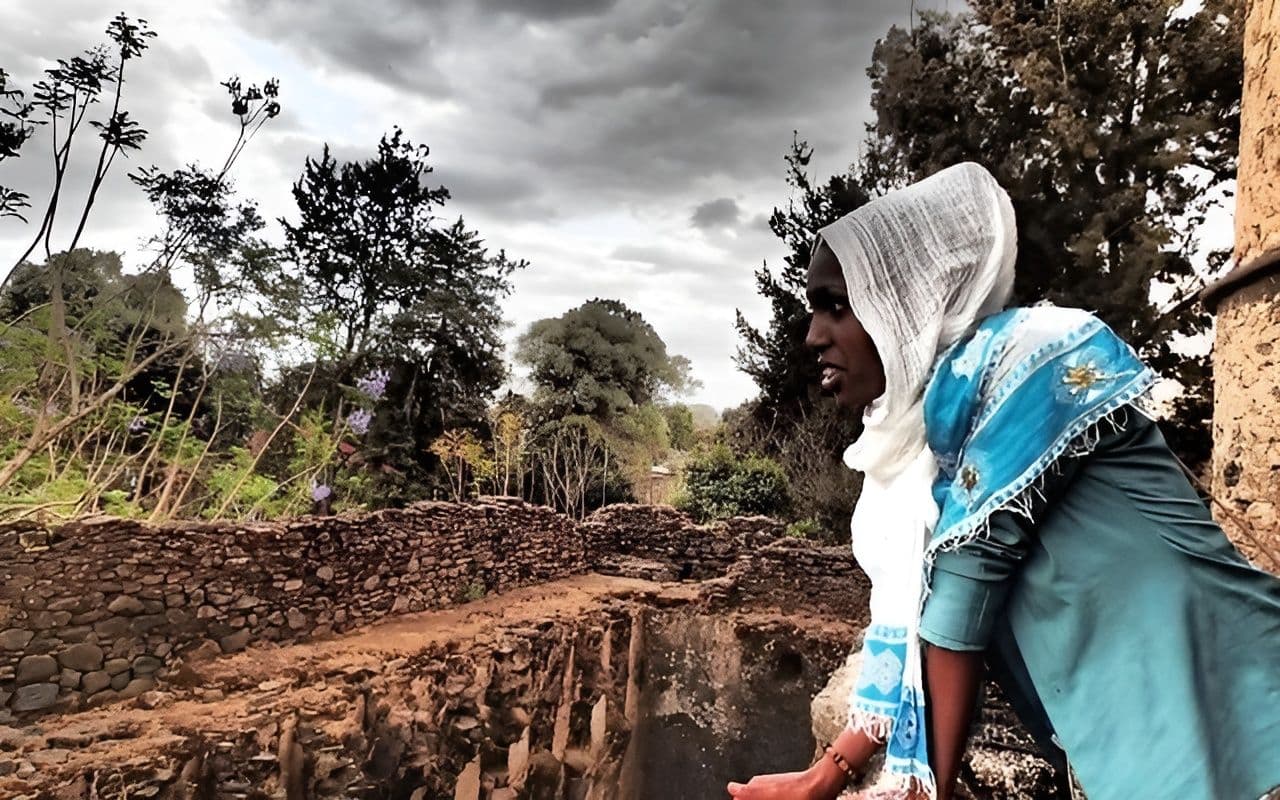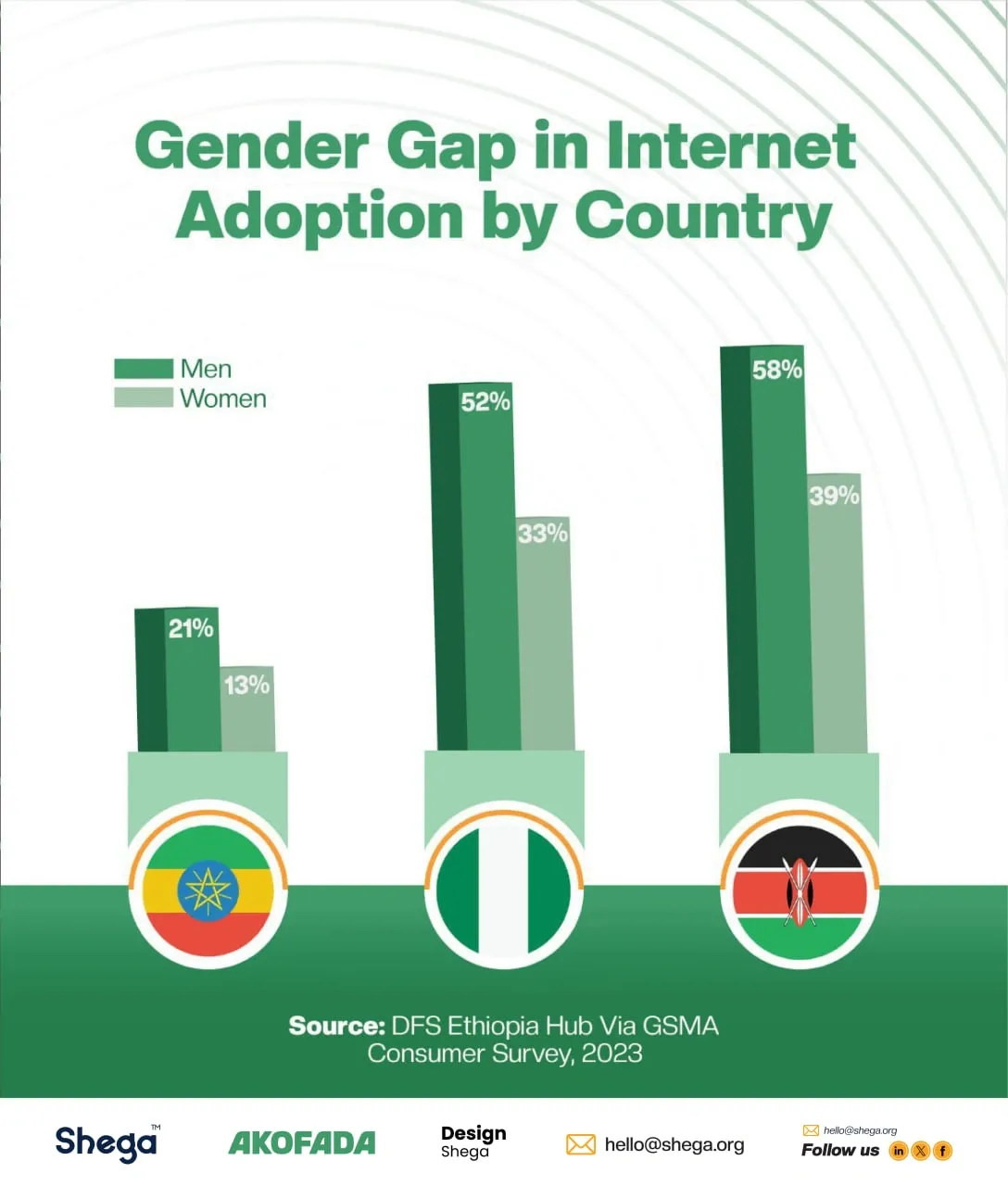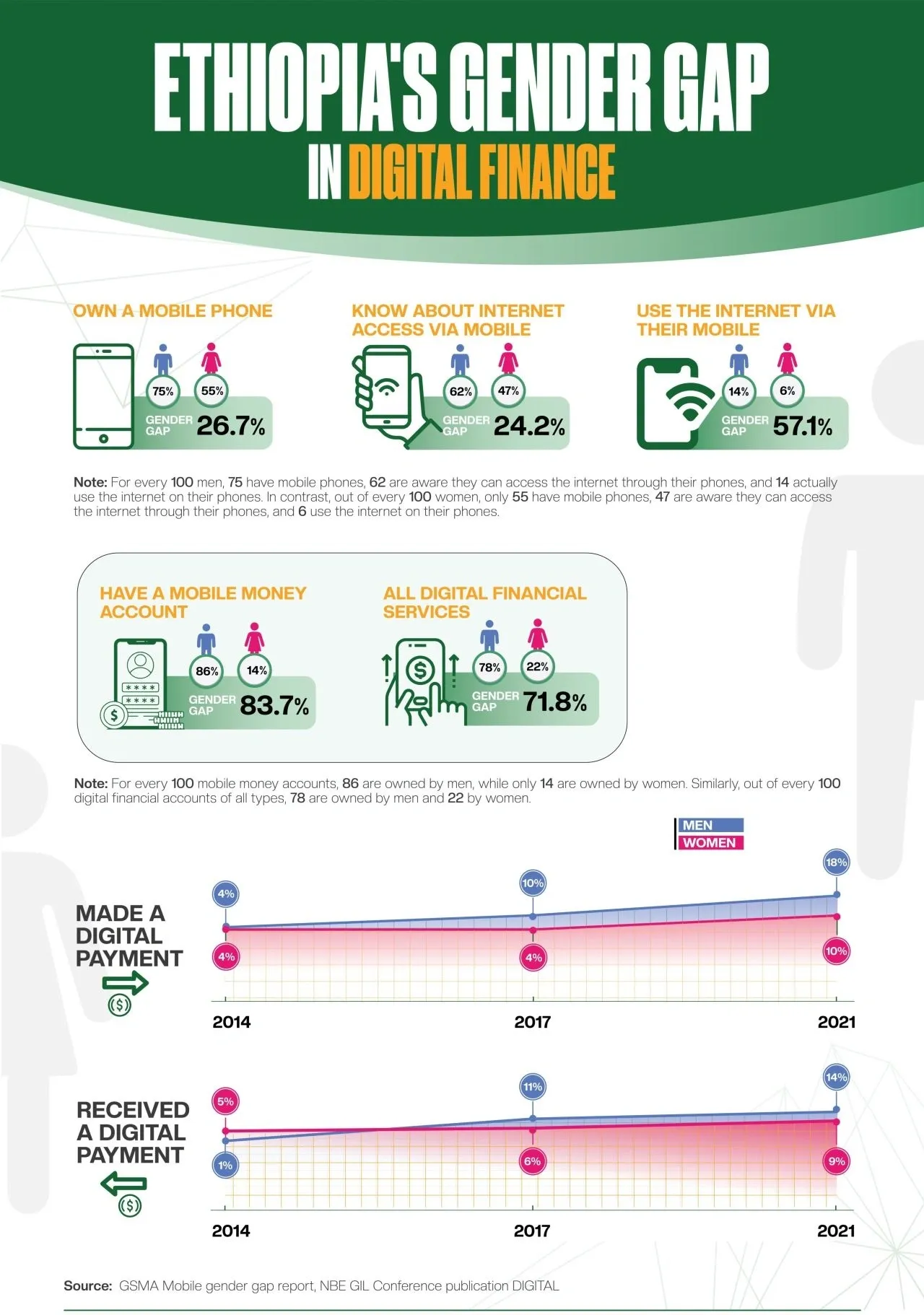Progress for 0 ad
Progress for 1 ad
Progress for 2 ad
Progress for 3 ad


Etenat Awol
Addis Ababa, Ethiopia

Ethiopian women face pronounced financial exclusion, with only 35% having access to formal financial services compared to 48% of men. Women also hold just 14% of mobile money accounts. Structural barriers such as limited asset ownership, digital illiteracy, and restrictive social norms continue to hinder their financial inclusion.
Female representation in banking and fintech leadership is also minimal. While several local initiatives aim to bridge the gap, true inclusion demands gender-intentional policies, tailored financial products, and improved digital access.
This article is an output of AKOFADA (Advancing Knowledge on Financial Accessibility and DFS Adoption), a project working to increase knowledge and transparency within Ethiopia’s DFS ecosystem. Featured Image Source- AF
___
Growing up, I primarily lived in a household where my mother shouldered the dual responsibilities of motherhood and contributing to our family's income. This included managing household chores, ensuring my younger siblings and I focused on our studies, and contributing financially.
And no, it wasn’t because my father was absent. But my mom was “it” for me. She is the one who taught me some basics of geography and spurred my interest in literature.
But I haven't been able to wrap my head around the fact that she didn't have a bank account until recently, despite her literacy. Mind you, my mother has a better education than my father. In stark contrast, I don’t remember a time when my father didn’t have one. He had it even way before the Commercial Bank of Ethiopia opened a branch in our rural town, Kutaber, near Dessie (Amhara Region).
This scenario begs the question, even in households with educated women, why are women not primary users of financial accounts? This issue extends beyond the typical considerations and demands deeper reflection within the financial services sector.
The story is not unique to my mother. With only 29% of total adult accounts being owned by women in Ethiopia and a significant portion being proxies for male counterparts, women have been largely left out by the banking system.
According to the World Bank’s Global Findex Report, only 35% of women in Ethiopia have access to formal financial services, compared to 48% of men. This gap is even more pronounced in rural areas, where women are often excluded from the formal economy and rely on informal financial mechanisms.
Interestingly, women constitute 70% of microfinance borrowers, reflecting their reliance on microfinance institutions for credit to support small-scale economic activities like trading, agriculture, and handicrafts. However, despite this high representation, women rarely transition to accessing larger loans or formal financial services. This is primarily due to structural barriers such as lack of collateral (as women often do not own land or assets in their names), limited financial literacy, and restrictive social norms that hinder their mobility and decision-making power.
The figures for digital financial services (DFS) adoption don't seem to be faring better, with only 14% of the 90 million mobile money accounts in Ethiopia belonging to women as of December 2023, underscoring the significant gender disparity in DFS adoption.
In a country where 64% of households are engaged in agricultural activities, location significantly impacts access to and utilization of DFS by women. Beyond affordability and accessibility, women face challenges such as limited digital literacy, lack of access to devices and reliable internet, and societal norms that hinder their use of DFS.
Current metrics for measuring DFS adoption often fail to adequately capture women's specific experiences. For example, while women constitute 22% of the user base across all DFS, this data may not accurately reflect their actual usage, as women may not be the primary users within their households.
Additionally, these metrics often overlook the diverse needs and experiences of women across different socioeconomic backgrounds and geographical locations. To truly understand the gender gap in DFS adoption, we need more nuanced data that captures the realities of women’s financial lives.

The gender gap in financial inclusion and DFS is not merely a statistical anomaly; it is the result of systemic barriers that women face. An inaugural Country Gender Profile of Ethiopia (CGEP) published at the end of 2023 reveals persistent and multisectoral disparities between the country’s 59.3 million female and 60.4 million male citizens. These inequalities are particularly pronounced in economic participation, access to finance, and digital technology adoption, painting a stark picture of the challenges women face in Ethiopia.
The report formulated through the collaboration of the African Development Bank (AfDB), the United Nations, and the Ministry of Women & Social Affairs, shows that mobile phone ownership among women stands at just 55%, compared to 76% among men. This digital divide not only limits women’s access to information and opportunities but also restricts their ability to participate in the growing digital economy.
The economic inequality extends to the labor market, where women are significantly underrepresented in formal and high-growth sectors. Only 14% of the workforce in the transport, communication, and storage sectors are women, while a staggering 74% of women in the labor force are concentrated in agriculture. Overall, women’s participation in the labor force is limited to 56.8%, compared to 72.6% for men.
Even when employed, women are more likely to work in the informal sector (28.6% of women versus 15.7% of men). Additionally, nearly half of the female workforce (45.3%) is engaged in unpaid family work, a figure that drops to 30.4% for men.
According to the gender profile report, these inequalities often begin early in life, with gender disparities affecting girls’ access to education and opportunities. The CGEP also highlights how these early disadvantages ripple into adulthood, limiting women’s economic potential and perpetuating cycles of poverty and exclusion.
Beyond economic and labor market disparities, women face significant barriers in accessing and utilizing DFS. Limited digital literacy, lack of access to devices, unreliable internet connectivity, and restrictive societal norms all contribute to their exclusion. For example, a study found that one-third of married women in rural Ethiopia do not own or have access to a mobile phone—a figure twice that of men. These challenges are compounded by cultural norms that often prioritize men’s access to resources and decision-making, further marginalizing women in the digital and financial spheres.
Given these multifaceted challenges, the question is, how can service providers and policymakers devise a multi-pronged approach to bridge these gaps? What steps are already being taken to address these issues, and how can these efforts be scaled up to ensure meaningful inclusion for women in Ethiopia’s economic and digital landscape?
Ethiopia's refreshed National Financial Inclusion Strategy (2021-2025) targets improving women's financial inclusion, and addressing the significant gender gap. The strategy focuses on expanding digital financial services, enhancing financial literacy, and creating gender-sensitive products like savings accounts and credit facilities.
It also emphasizes improving access to identification documents and leveraging mobile money to reach rural women. By aiming to increase women's financial inclusion to 50% by 2025, the strategy seeks to empower women economically and promote inclusive growth.
To address the gender gap in financial services, financial institutions such as the Bank of Abyssinia provide products specifically designed for women.
The Zahrah Saving Account, offered by the nation’s oldest bank, is a specialized savings product tailored for women, featuring competitive interest rates and no minimum balance requirement is one of the products that aim to promote women’s financial inclusion.
Enat Bank, the only women-focused financial institution also provides tailored savings accounts and microloans for women through its digital lending product Malefiya, while the Commercial Bank of Ethiopia offers women savings accounts and provides microfinance and SME loans to support women-led enterprises. Cooperative Bank of Oromia’s Michu is another uncollateralized lending platform that targets women. 
However, most of these interventions often focus on women who already have bank accounts. As a result, they might not effectively address the gender gap, particularly for unbanked women in rural areas.
One project that’s working to improve financial access in Ethiopia while being gender intentional is SAFEE by Kifiya Financial Technology and Mastercard Foundation. The duo launched the 100-million-dollar program last year with the goal of unlocking financial access for MSMEs in Ethiopia. with a particular focus on women. SAFE aims to provide uncollateralized loans to 477,800 MSMEs, including 425,000 women who will also benefit from mobile device financing.
The lack of disaggregated data is also an obstacle that hinders the effectiveness of many initiatives. According to the World Bank Gender Data Portal, data on the share of businesses owned by women in Ethiopia is not available, limiting the ability to effectively target and evaluate programs that aim to support women entrepreneurs.
The persistent lack of disaggregated data on the gender divide in digital financial services in Ethiopia means there is insufficient information on key metrics such as gender-specific usage patterns of mobile banking and digital payments, the impact of digital financial services on women’s economic empowerment, and women’s financial adoption cycles, which hinders the ability to design targeted interventions and measure progress in closing this widening gap. Even though the adoption of digital financial services in Ethiopia is increasing, it doesn’t necessarily translate to addressing the needs of women or contributing to the closing of the gender divide.
The widening gender gap is also accompanied by disparity in financial leadership. In 2023, women occupied only 18% of C-suite roles globally. This stark contrast is even more pronounced in Ethiopia. While 26 out of 32 commercial banks in the country have at least one female board member, women hold only 15% of board positions & 12.5% of senior management roles, falling short of the National Bank of Ethiopia's 25% target, according to an ongoing research by the Gender Innovation Lab.
Administrative data from one major commercial bank shows that female staff have similar levels of experience and education and slightly higher performance ratings on average—yet male employees are twice as likely to hold managerial positions, occupy higher levels of seniority, and earn significantly more than their female counterparts.
This data gets even exacerbated when it comes to CEO roles in financial institutions. Notable exceptions include Melaika Bediri CEO of ZamZam Bank and Emebet Melese (PhD) President of the Development Bank of Ethiopia. Two weeks ago, the Board of Directors at Hibret Bank nominated Tsigereda Tesfaye to serve as its president.
Meanwhile, when it comes to data on female founders in Ethiopian fintech startups, information is limited. However, at face value, with the exception of Equb Financial Technologies, there appears to be a scarcity of female founders or fintech startups led by women. This limited representation may influence the types of products and solutions offered by the fintech sector as it strives to influence the digital financial landscape of the country.
Sewit Haileselassie, a gender analyst working with the Women’s Digital Financial Inclusion Advocacy Hub under UNCDF, argues, “The pervasive lack of female leadership in the financial sector manifests systemic problems that resonate with profound implications, extending far beyond the boardrooms and into the fabric of society as it has been reflected upon ad nauseam,” she wrote in a piece titled "Does the Financial Sector Leave Women Behind?"
According to the gender analyst, policies and initiatives that lack gender intentionality, despite being well-intentioned, risk leaving over half of the population behind, resulting in far-reaching consequences.
A joint NBE-World Bank report titled Making the Financial Sector Work for Women outlines ten evidence-based recommendations for Ethiopia's financial sector, including collecting gender-disaggregated data, enhancing women's digital literacy, and promoting women's leadership through mentorship and career advancement initiatives.
Ethiopia’s National Financial Inclusion Strategy and National Digital Payment Strategy represent critical steps toward expanding access to financial services, with a deliberate focus on women. Yet, despite these efforts, the gender gap in DFS adoption remains stark. This persistent disparity shows the need for more targeted interventions that address the unique barriers women face ranging from limited digital literacy and device access to deeply entrenched societal norms.
Financial institutions have begun to respond, introducing initiatives like women’s savings accounts. However, these measures often fall short of addressing systemic challenges. A more holistic approach is an essential one that integrates gender-sensitive product design, targeted financial literacy programs, and inclusive marketing strategies to bridge the gap effectively.
Closing the gender gap in DFS adoption is not just a moral imperative but an economic one. With women constituting 59.3 million of Ethiopia’s population and 74% of the female labor force engaged in agriculture, their full participation in the digital economy could unlock crucial growth.
👏
😂
❤️
😲
😠

Etenat Awol
Etenat holds a degree in Journalism and her master's in Public Relations. Previously, she served as a university lecturer and has five years of experience in communications, media, digital marketing, and consulting.
Your Email Address Will Not Be Published. Required Fields Are Marked *